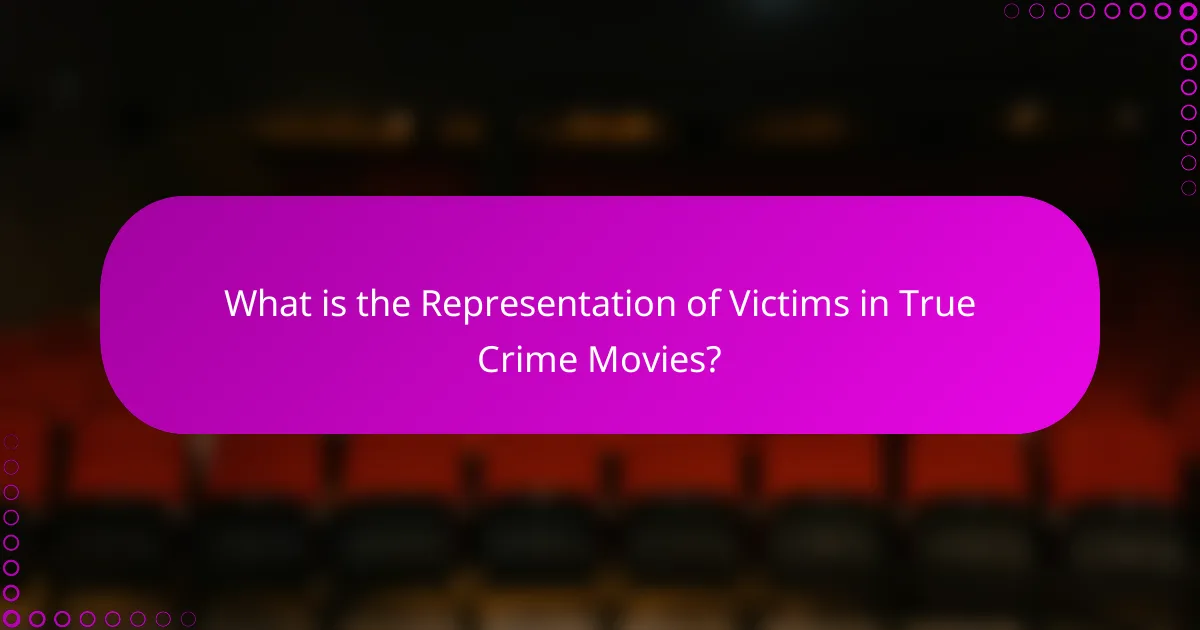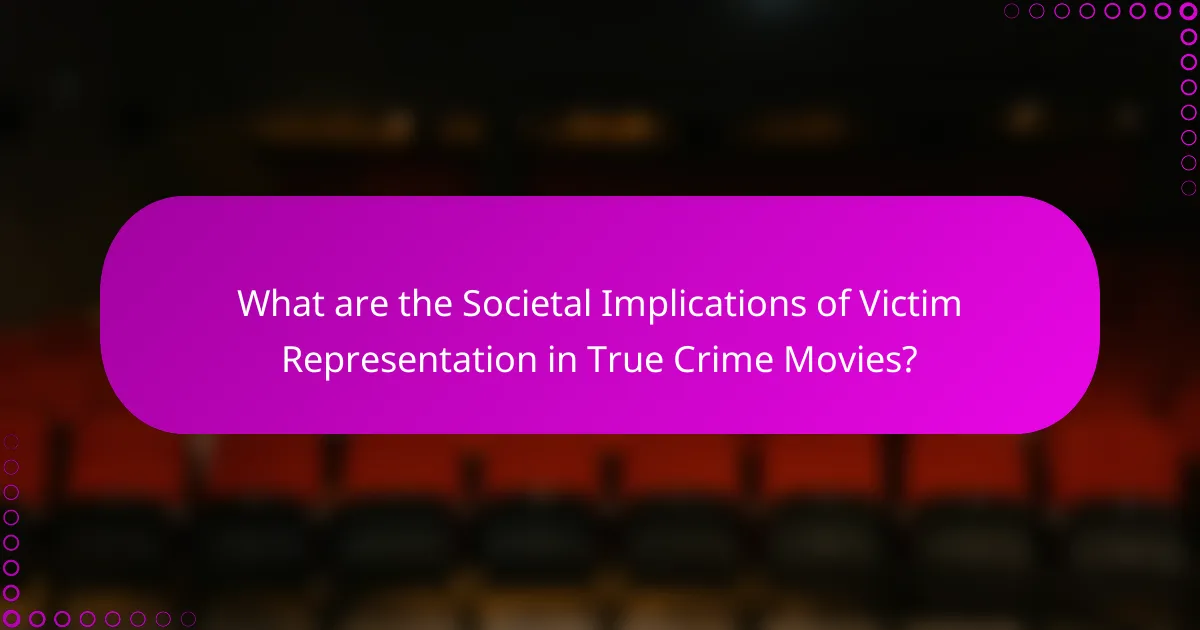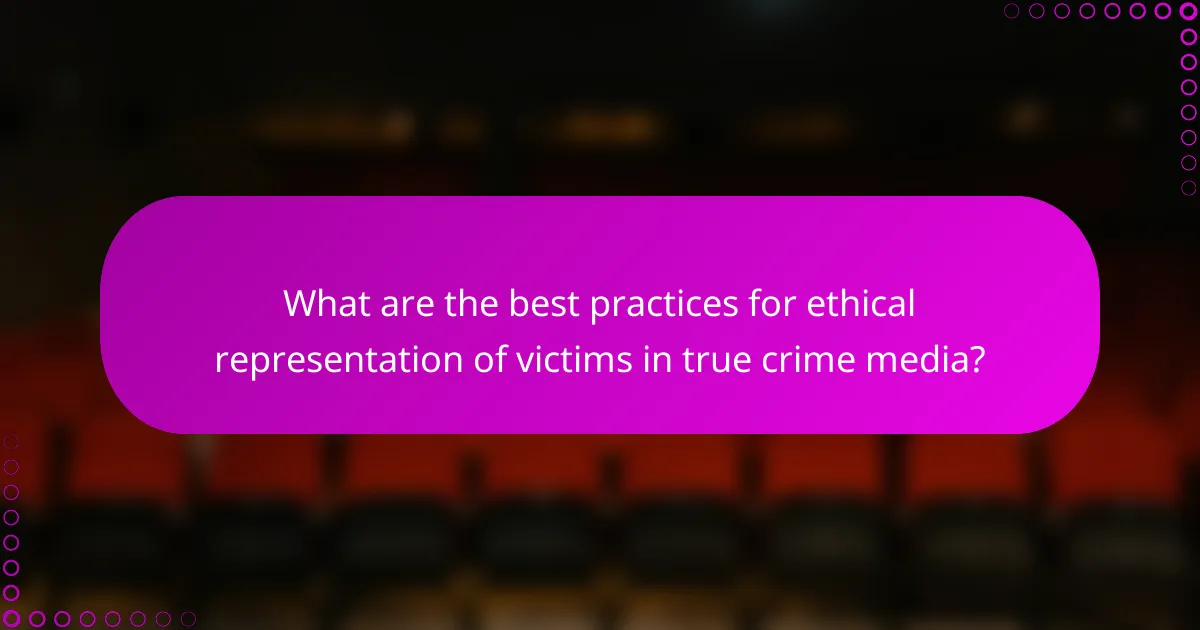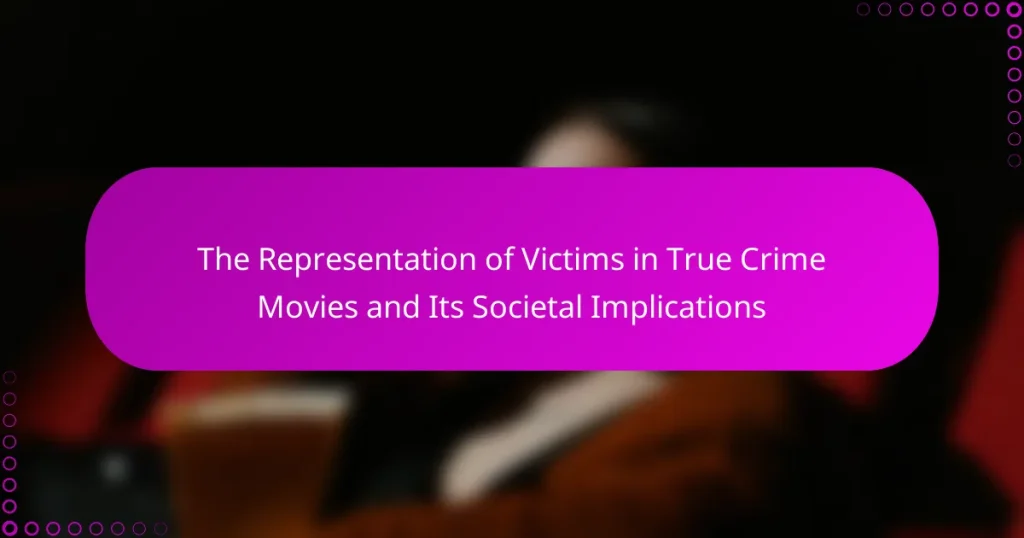The representation of victims in true crime movies plays a crucial role in shaping societal perceptions of crime and victimhood. These films often portray victims as vulnerable individuals, emphasizing their trauma while humanizing their backstories to foster viewer empathy. However, such portrayals can also sensationalize their experiences, leading to potential desensitization and reinforcing harmful stereotypes. Ethical representation practices are essential to ensure dignity and sensitivity towards victims, including accurate depictions, obtaining consent from families, and highlighting victims’ lives rather than solely their deaths. This article explores the implications of victim representation in true crime media and outlines best practices for ethical storytelling.

What is the Representation of Victims in True Crime Movies?
Victims in true crime movies are often portrayed as vulnerable individuals who suffer from violent crimes. This representation emphasizes their trauma and the impact of crime on their lives. True crime films frequently focus on the backstories of victims, aiming to humanize them. This approach can foster empathy among viewers. However, it may also sensationalize their experiences, potentially leading to a lack of sensitivity. Research indicates that such portrayals can influence public perception of crime and victimhood. Studies have shown that media representation can shape societal attitudes toward real-life victims.
How do true crime movies portray victims?
True crime movies often portray victims as relatable and innocent individuals. This representation aims to evoke empathy from the audience. Victims are frequently depicted with personal backstories that highlight their humanity. Filmmakers may emphasize their dreams, relationships, and struggles. This approach personalizes the victim, making their tragedy more impactful. Studies show that this portrayal can influence public perception of crime and victimhood. Victims are sometimes shown as symbols of broader societal issues, such as violence or injustice. Overall, true crime films shape narratives that can affect societal attitudes toward crime and its victims.
What common characteristics are depicted in these portrayals?
Common characteristics depicted in these portrayals include vulnerability, innocence, and victimization. Victims are often shown as relatable individuals, invoking empathy from the audience. They frequently exhibit traits such as trustfulness and naivety, making them appear more susceptible to crime. The narrative typically emphasizes their backstory, highlighting their humanity. This portrayal can reinforce societal stereotypes about victims and crime. Studies indicate that such representations influence public perception of crime and victimhood. For instance, research shows that audiences may develop biased views based on these depictions. These characteristics collectively shape the societal understanding of victims in true crime narratives.
How do filmmakers choose which victims to represent?
Filmmakers choose which victims to represent based on various factors. These factors include the victim’s story, public interest, and emotional impact. Filmmakers often seek narratives that resonate with audiences. High-profile cases tend to attract more attention and funding. The cultural relevance of the victim’s story also plays a role. Filmmakers may prioritize victims whose experiences highlight societal issues. Additionally, they consider the potential for advocacy or awareness-raising. Audience demographics can influence the choice of victims represented. Overall, the selection process is strategic and aims to engage viewers while addressing broader societal themes.
Why is the representation of victims significant in true crime narratives?
The representation of victims is significant in true crime narratives because it shapes public perception and understanding of crime. Accurate portrayals humanize victims, emphasizing their stories and experiences. This can foster empathy and awareness about the impact of crime on individuals and communities. Furthermore, victim representation can influence societal attitudes toward crime and justice. Research indicates that narratives focusing on victims can lead to increased advocacy for victims’ rights. For instance, studies show that victim-centered storytelling can enhance support for policy changes aimed at improving victim services.
What impact does victim portrayal have on audience perception?
Victim portrayal significantly influences audience perception. It shapes how viewers empathize with the victim and interpret their circumstances. Positive portrayals can foster sympathy and understanding. Conversely, negative portrayals may lead to victim-blaming or desensitization. Research indicates that viewers often align their beliefs with the narratives presented. For instance, a study by Tuchman (1978) highlights that media representations can reinforce stereotypes. This demonstrates that the way victims are depicted affects societal attitudes and responses.
How does victim representation influence societal attitudes towards crime?
Victim representation significantly influences societal attitudes towards crime. When victims are portrayed empathetically in media, it fosters public sympathy and awareness. This portrayal can lead to increased support for victim rights and advocacy. Conversely, negative or simplistic representations may perpetuate stereotypes and desensitize audiences. Research indicates that media framing affects public perception of crime severity and victim credibility. For instance, a study by Surette (2015) highlights how victim narratives shape community responses and policy discussions. Thus, effective victim representation can enhance societal understanding and responsiveness to crime issues.

What are the Societal Implications of Victim Representation in True Crime Movies?
Victim representation in true crime movies has significant societal implications. These films often shape public perceptions of crime and victimhood. Misrepresentation can lead to stereotypes about victims and offenders. For instance, the portrayal of victims as helpless can reinforce societal stigma. Studies indicate that sensationalized depictions may desensitize audiences to real-life violence. This can affect empathy levels towards actual victims. Furthermore, these representations can influence criminal justice policies and public opinion on safety. The impact extends to how communities respond to crime and support victims.
How do true crime movies affect public understanding of crime and justice?
True crime movies shape public understanding of crime and justice by dramatizing real-life events. They often highlight the complexities of criminal cases. This portrayal can lead to increased awareness of systemic issues within the justice system. For example, films like “The Central Park Five” showcase wrongful convictions and racial bias. Viewers may develop misconceptions about crime rates and the nature of justice. Research indicates that sensationalized narratives can skew perceptions of victimization. A study published in the journal “Crime, Media, Culture” found that audiences often overestimate the prevalence of violent crime after viewing such content. Overall, true crime movies influence societal attitudes towards crime and justice, often blending fact with dramatization.
What misconceptions arise from victim portrayals in these films?
Victim portrayals in true crime films often lead to misconceptions about their experiences and characteristics. These films frequently depict victims as passive or helpless, which can distort public perception of real-life victims. Many viewers may assume that victims did not take steps to protect themselves, ignoring factors like coercion or manipulation. Additionally, films often sensationalize victim narratives, leading audiences to believe that all victims fit a certain profile. This can perpetuate stereotypes about vulnerability based on gender, socioeconomic status, or lifestyle choices. Research indicates that such portrayals can contribute to victim-blaming attitudes in society. Misconceptions can also arise from the dramatization of events, which may not accurately reflect the complexities of real-life situations. Overall, these portrayals can shape societal attitudes towards victims in harmful ways.
How do these portrayals contribute to the stigma surrounding certain victims?
Portrayals in true crime movies contribute to the stigma surrounding certain victims by reinforcing negative stereotypes. These films often depict victims in a sensationalized manner. This portrayal can lead to public misconceptions about the victims’ character or choices. For example, victims of violent crimes may be shown as weak or irresponsible. Such representations can diminish empathy and understanding from society. Studies indicate that media portrayals significantly influence public perception. The portrayal of victims can shape attitudes and beliefs about similar real-life cases. Therefore, these films can perpetuate harmful stigma against certain groups of victims.
What role does media play in shaping societal views on crime victims?
Media plays a significant role in shaping societal views on crime victims. Through news coverage and entertainment, media influences public perception and understanding of victimization. Sensationalized reporting can create stereotypes about victims, often portraying them in ways that affect societal empathy. Research shows that extensive media coverage can lead to increased awareness but also victim-blaming narratives. For instance, studies indicate that portrayals of victims in true crime shows often emphasize their vulnerabilities, impacting how society perceives their responsibility in the crime. This representation can skew public opinion, leading to misconceptions about crime and victimhood. Thus, the media’s framing of crime victims is crucial in shaping societal attitudes and responses.
How do true crime documentaries differ from dramatized films in their portrayal of victims?
True crime documentaries portray victims with a focus on factual accuracy and real-life context. They often include interviews with family members and friends, providing personal insights into the victim’s life. This approach aims to humanize the victims, emphasizing their stories and the impact of the crime on their loved ones. In contrast, dramatized films frequently prioritize entertainment value over factual representation. They may embellish or fictionalize details, leading to a sensationalized portrayal of victims. This can distort the public’s perception of the victim’s reality and the circumstances surrounding the crime. True crime documentaries rely on archival footage and police records, ensuring a grounded representation. Dramatized films often use actors and scripted dialogue, which can create a disconnect from the actual events.
What responsibilities do filmmakers have in representing victims ethically?
Filmmakers have a responsibility to represent victims ethically by ensuring accuracy and sensitivity in their portrayals. They must prioritize the dignity of victims and their families. This includes obtaining consent when possible and avoiding sensationalism. Ethical representation helps prevent further trauma to victims and their loved ones. Filmmakers should also consider the societal impact of their narratives. Misrepresentation can perpetuate stereotypes and misinformation. Research indicates that ethical storytelling fosters empathy and understanding. Therefore, filmmakers play a crucial role in shaping public perception through responsible representation.

What are the best practices for ethical representation of victims in true crime media?
Ethical representation of victims in true crime media involves several best practices. First, prioritize the dignity of victims by avoiding sensationalism. Second, ensure accurate portrayal of events and facts surrounding the case. Third, obtain consent from victims’ families when possible, respecting their wishes regarding representation. Fourth, provide context to the crime, including societal factors that may have contributed. Fifth, avoid graphic depictions of violence to prevent re-traumatization. Sixth, highlight the victims’ lives, not just their deaths, to humanize them. Lastly, engage with experts in victimology to guide ethical storytelling. These practices promote respect and sensitivity towards victims and their families.
How can filmmakers ensure respectful and accurate portrayals of victims?
Filmmakers can ensure respectful and accurate portrayals of victims by prioritizing sensitivity and research. They should conduct thorough interviews with victims or their families to capture authentic experiences. Collaboration with experts in trauma and victimology can provide valuable insights. Filmmakers must avoid sensationalism and focus on the human aspects of the victims’ stories. Transparency in storytelling helps to honor the victims’ dignity. Additionally, seeking feedback from advocacy groups can guide respectful representation. Research indicates that accurate portrayals can foster empathy and understanding among audiences.
What guidelines should filmmakers follow to avoid sensationalism?
Filmmakers should prioritize authenticity and sensitivity in their portrayals. They must conduct thorough research to accurately represent events and individuals. Avoiding exaggerated narratives is crucial. Filmmakers should focus on the human experience rather than sensational details. They must respect the victims and their families by seeking consent when possible. Including expert opinions can provide context and depth. Sensationalized content can lead to public desensitization and misinformation. Adhering to ethical storytelling practices fosters responsible filmmaking.
How can audience awareness be raised regarding victim representation issues?
Raising audience awareness regarding victim representation issues can be achieved through targeted education and media literacy initiatives. Educational programs can inform audiences about the ethical implications of victim portrayal in true crime media. Workshops and discussions can facilitate critical thinking about the narratives presented in these films. Social media campaigns can highlight real victim stories and advocate for respectful representation. Collaborations with advocacy groups can provide expert insights on victim rights and representation. Research indicates that informed audiences are more likely to question harmful stereotypes and narratives. For example, studies show that media literacy can lead to increased empathy and understanding of victim experiences.
What resources are available for understanding victim representation in media?
Resources for understanding victim representation in media include academic journals and books focused on media studies. Notable journals include “Media, Culture & Society” and “Journal of Communication.” Books such as “The Victimization of Women: Law, Policies, and Politics” provide in-depth analysis. Online databases like JSTOR and Google Scholar offer access to research articles. Documentaries and films on true crime also serve as valuable resources. Additionally, organizations like the Media Psychology Division of the American Psychological Association publish relevant studies. These resources collectively enhance understanding of how victims are portrayed in media.
Where can filmmakers find support for ethical storytelling practices?
Filmmakers can find support for ethical storytelling practices through various organizations and resources. The International Documentary Association (IDA) offers guidelines and resources for ethical filmmaking. Additionally, the National Association of Broadcasters (NAB) provides ethical standards for media professionals. Filmmakers can also refer to the Ethical Journalism Network for principles on responsible storytelling. Furthermore, workshops and training programs focused on ethics in storytelling are available through film schools and industry conferences. These resources help ensure that filmmakers approach sensitive topics with care and respect.
What organizations focus on victim advocacy and media representation?
Organizations that focus on victim advocacy and media representation include the National Center for Victims of Crime and the Victim Rights Law Center. The National Center for Victims of Crime provides resources and support for victims. They advocate for legal reforms and public awareness. The Victim Rights Law Center offers legal assistance to victims of crime. They focus on ensuring victims’ rights are upheld in the media. Both organizations contribute to improving the representation of victims in various media forms. Their efforts aim to raise awareness and promote sensitivity towards victims’ experiences.
The main entity of this article is the representation of victims in true crime movies. The article examines how these films portray victims, often emphasizing their vulnerability and personal backstories to evoke empathy, while also discussing the potential for sensationalism and its impact on public perception. It highlights the societal implications of victim representation, including the influence on crime narratives, victim advocacy, and the formation of stereotypes. Additionally, the article outlines best practices for ethical representation and the responsibilities filmmakers have in portraying victims sensitively and accurately.


